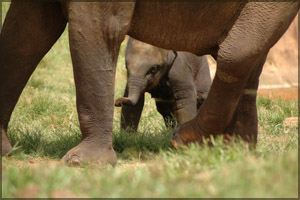Elephantine misconceptions
From human-elephant conflict to human-elephant
coexistence:
By Sajitha PREMATUNGE
[email protected]
People and elephants have lived in harmony for nearly thousand years.
So why have reports on human-elephant conflict escalated as of late?
|

“We don’t wont to take a risk where human beings are concerned.” |
With the liberation of the East, as more protected areas have become
accessible and with the increased man power the records of conflicts
have invariably increased, coupled with the undue publicity given by
some media to such unfortunate confrontations giving the false
impression that conflicts have increased in number.
Although there undoubtedly may be an increase in the number of
incidents, there are many misconceptions about our gentle giants.
Apart from the irresponsible conduct of some media in providing
unnecessary publicity to incidents of human-elephant, Minister of
Environment and Natural Resources, Patali Champika Ranawaka identifies
that, increased number of recorded elephant deaths due to the increase
of vet surgeons, gives the false impression that conflicts have
escalated.
“New counts in newly liberated areas like Batticaloa have helped to
increase the numbers. But that doesn’t mean that the human elephant
conflict has escalated. This has happened in these very same areas
before, it’s just that nobody was there to record them.”
The Minister pointed out that dealing with human-elephant conflict
and elephant conservation - keeping in mind both the interests of the
people as well as the elephants is easier said than done.
“The major difficulty we face, in terms of management, is terrorism.”
The Minister pointed out that Wilpattu and Yala make up 50% of national
protected areas, both of which were affected by terrorism. If favourable
conditions for elephants are not maintained in the protected areas the
carrying capacity (number of elephants the area can support) is bound to
go down.
Consequently the Department of Wildlife Conservation adopts habitat
enrichment methods such as taking out invasive species, maintenance of
water holes in the area and controlled burning, to facilitate the growth
of new young grass as a food source for elephants. “But habitat
enrichment is impossible if the protected area is under continuous
terrorist attacks.”
Dr. Prithiviraj Fernando, Chairman CCR (Centre for Conservation and
Research), speaking with the experience of tracking a heard of some
thirty elephants with the help of radio collars, stressed the importance
of understanding elephant ecology for elephant conservation.
“Just putting up a fence is not conservation” he said, as opposed to
the popular belief. Their research indicates that the best elephant
habitat is a mosaic of open areas and regenerating forests. He said that
although one can never be certain about the total figure of elephants in
Sri Lanka there are around 6000 elephants (10% of world elephant
population) using only 2% of the total land area of Sri Lanka. The home
range of a Sri Lankan elephant is 50 to 100 square km as opposed to 500
to 1000 square km of Indian elephants.
As Dr. Fernando explains the secret behind the increased carrying
capacity is the land use patterns of the Sri Lankan people. “People have
been generating favourable conditions for elephants for over 1000 years
now.”

The chena provides them food while the irrigation system provides
them water they would have otherwise been forced to find themselves. But
the human elephant conflict arises when human territory and habitats
overlap. The Minister told the Sunday Observer that the main reason for
the escalation of human-elephant conflict is unplanned village
structures.
“50% of the human elephant conflicts in Sri Lanka takes place in and
around Irudeniyaya,” an unplanned settlement situated between Thabbowa
and Thahallapallekele. The Minister explained that during the dry season
the Thabbowa sanctuary dries up. As a result elephants migrate to
Thahallapallekele during the dry season for foraging.
“But Irudeniyaya was built in the middle of their natural migration
path. Conflicts are inevitable.” He explained that for the time being
the only temporary solution is to drive the elephants to either side.
“But then the elephants forced back to Thabbowa will not have adequate
food.”
The Minister identified unplanned plantations as another instigating
factor. “Elephants love sugarcane and the sugarcane cultivations in
Lunugamwehera acts as an attraction to elephants resulting in
conflicts.”
Garbage dumps are another instigating factor. The Minister said that
they are fully aware of the adverse effects of ‘elephant drives’, but do
not have a choice but to do so when the elephant habitats and human
territory crosses paths.
“We are fully aware that the elephants return to the same place year
after year. But we don’t wont to take a risk where human beings are
concerned.” But is there a way for humans and elephants to live in
coexistence. Both the Ministry as well a the academics have many tricks
up their sleeves. Protected areas of Sri Lanka, which adds up to 1.2
million ha, if perfectly managed, has a carrying capacity of around 1200
elephants.
But then where are all the other elephants? “Outside the park.” says
Dr. Dewaka Weerakoon, Senior Lecturer, University of Colombo. “Space
outside parks is, therefore, of critical value to elephants. Driving
elephants into parks is not a solution.” He explains that one must
always keep in mind the issue of carrying capacity.
“If the parks are over their carrying capacity, driving more
elephants into the parks not only endangers the new population but also
the existing one.” “It’s like squeezing 200 people into a whole that can
hold only 100 people.” Said Dr. Prithiviraj.
|

Dr. Davaka Weerakoon |

Dr. Prithiviraj Fernando |
Dr. Prithiviraj claims that The Managed Elephant Reserve, done in
collaboration with the Department of Wildlife Conservation - as part of
their National Policy - is a foolproof strategy. This involves a radical
method of integrating human and elephant habitat to ensure coexistence
of the two species by cultivating chena! “Chena provides a rich source
of fodder for elephants.”
He further explained that they are by no means trying to advocate
chena cultivation, which is technically illegal in Sri Lanka. “But
people are still doing it anyway, outside Protected Areas, in state
land. So what we are proposing is, that the existing chenas be
regulated. Protected Areas will continue to remain untouched by human
activity.”
Dr. Prithiviraj and Dr. Devaka points out that there are around 1000
square km of chena that support 3000 elephants, while the 6000 square km
of National Parks support approximately 2000. Dr. Prithiviraj claims
that this indicates that a large number of elephants are supported by
chenas.
Supposing that chenas are able to support the populations of
elephants living outside parks, what prevents them from attacking human
settlements? Dr. Devaka explains “The problem never arises. For almost a
thousand years humans and elephants have managed to live in harmony.
During the wet season people cultivate chenas and during the dry
season - when cultivation ceases and people move out - elephants move
into chenas, since there is not enough food for them within the parks.”
But admitting that it is always better to take precautions, Dr. Devaka
suggests that electric fences be put up around villages.
“Keeping people in an elephant habitat and trying to drive the
elephants out won’t work.” explained Dr. Devaka. “The settlements will
be subjected to repeated attacks, because elephants will always attempt
to return to their habitat.”
But, as identified by Dr. Prithiviraj and Dr. Devaka, the main
obstacle for this sort of a coexistence is that the people consider
elephants as a problem. “But if we show them that they can also benefit
from elephants, they will learn to tolerate elephants.” Dr. Devaka
explained that eco-tourism can be adopted as a source of extra income
for the villagers. “It will be a win situation. This way villagers will
realise that elephants are not just another ‘problem’.”
The best thing about Managed Elephant Ranges - as pointed out by Dr.
Devaka - is that the elephants do not have to be forced back to the
park. “There is more than enough food for elephants in the parks during
wet season. They always go back to the park without any prompting.
” They strongly believe that Managed Elephant Ranges are the best
method for areas with seasonal land use methods - specially considering
its economical viability - and claimed that this method would be very
practical for the southern regions of the island as well.
But the Ministry for their part, had not remained idle. “We want to
redefine Human-elephant conflict as ‘Human elephant-coexistence’.” And
their plan is habitat enrichment. He explained that the Ministry hopes
to focus specially on areas that have been affected by terrorism, taking
out invasive species like cows that have become a threat to elephants of
Lunugamvehera and Udawalawe.
The Udawalawe Eth Athuru Sewana is also proposed to be expanded. An
accelerated programme of installing electrical fences, is currently
under way and will be finished by 2011. 800 personnel will be appointed
to different protected areas, under Department of Wild Life’s newest
programme Gajamithuro.
Task forces of local, regional as well as national levels will being
formulated, the pilot project of which was successfully completed,
recently in Kurunegala. Concurring with Dr. Prithiviraj on the prospects
of eco-tourism, Minister Patali Champika Ranawaka claimed the Ministry
wishes to promote eco-tourism of elephants and the blue whales.
But the most promising prospect may be the proposed elephant hoarding
grounds for problematic elephants. Both Lunugamvehera and Ritigala
hoarding grounds comprise of 5000 ha.
The Lunugamwehera elephant hoarding ground is to be opened in
December. Dr. Prithiviraj identifies elephant hoarding grounds as one of
the sound solutions to the human-elephant conflict, providing necessary
consideration given to issues like practicality and carrying capacity.
“Translocation of elephants only translocates the problem. An adult
male elephant that is translocated due to its behaviour, will cause
trouble wherever it goes. Our idea is to relocate not only the elephant
but the problem as well.” |

